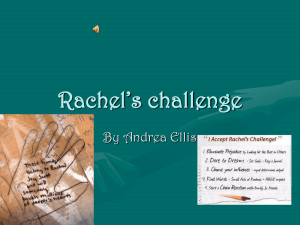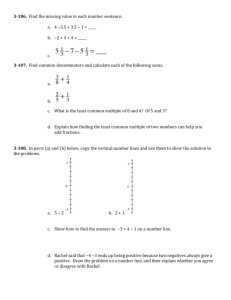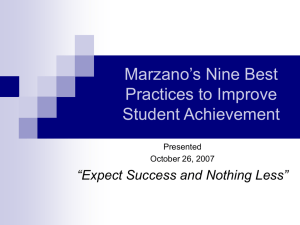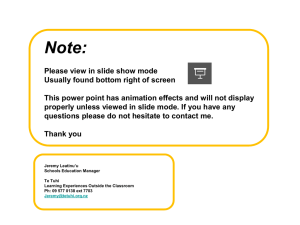Rachel Reevaluation Integrated Assessment VI 2-27-13
advertisement
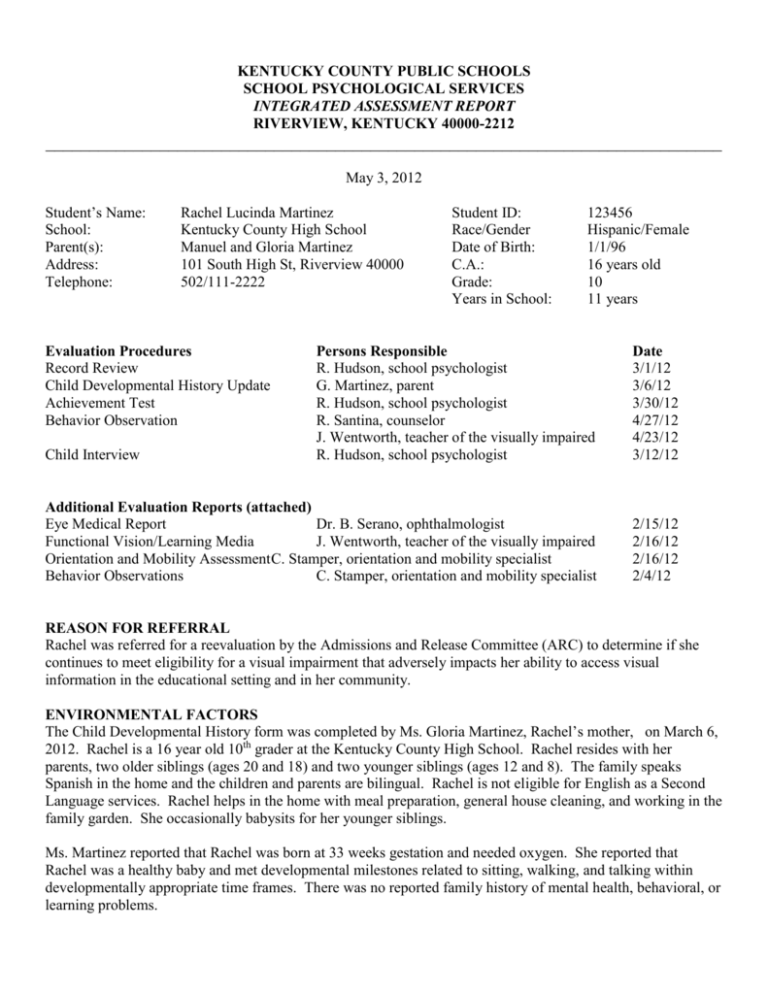
KENTUCKY COUNTY PUBLIC SCHOOLS SCHOOL PSYCHOLOGICAL SERVICES INTEGRATED ASSESSMENT REPORT RIVERVIEW, KENTUCKY 40000-2212 _____________________________________________________________________________ May 3, 2012 Student’s Name: School: Parent(s): Address: Telephone: Rachel Lucinda Martinez Kentucky County High School Manuel and Gloria Martinez 101 South High St, Riverview 40000 502/111-2222 Evaluation Procedures Record Review Child Developmental History Update Achievement Test Behavior Observation Student ID: Race/Gender Date of Birth: C.A.: Grade: Years in School: 123456 Hispanic/Female 1/1/96 16 years old 10 11 years Persons Responsible R. Hudson, school psychologist G. Martinez, parent R. Hudson, school psychologist R. Santina, counselor J. Wentworth, teacher of the visually impaired R. Hudson, school psychologist Date 3/1/12 3/6/12 3/30/12 4/27/12 4/23/12 3/12/12 Additional Evaluation Reports (attached) Eye Medical Report Dr. B. Serano, ophthalmologist Functional Vision/Learning Media J. Wentworth, teacher of the visually impaired Orientation and Mobility Assessment C. Stamper, orientation and mobility specialist Behavior Observations C. Stamper, orientation and mobility specialist 2/15/12 2/16/12 2/16/12 2/4/12 Child Interview REASON FOR REFERRAL Rachel was referred for a reevaluation by the Admissions and Release Committee (ARC) to determine if she continues to meet eligibility for a visual impairment that adversely impacts her ability to access visual information in the educational setting and in her community. ENVIRONMENTAL FACTORS The Child Developmental History form was completed by Ms. Gloria Martinez, Rachel’s mother, on March 6, 2012. Rachel is a 16 year old 10th grader at the Kentucky County High School. Rachel resides with her parents, two older siblings (ages 20 and 18) and two younger siblings (ages 12 and 8). The family speaks Spanish in the home and the children and parents are bilingual. Rachel is not eligible for English as a Second Language services. Rachel helps in the home with meal preparation, general house cleaning, and working in the family garden. She occasionally babysits for her younger siblings. Ms. Martinez reported that Rachel was born at 33 weeks gestation and needed oxygen. She reported that Rachel was a healthy baby and met developmental milestones related to sitting, walking, and talking within developmentally appropriate time frames. There was no reported family history of mental health, behavioral, or learning problems. Martinez, Rachel Lucinda Page 2 The Martinez family moved from California to Kentucky when Rachel was age five. Rachel did not attend preschool. She has attended the Kentucky County Public Schools and has received vision services since her Kindergarten year. Rachel’s high school report card indicated an A/B average in all classes with the exception of Math where she earned Cs with noted teacher concerns. Attendance records indicated good school attendance (one to five absences per school year). Scores on the state assessment, Kentucky Core Content Test, indicated grade level performance in all areas with the exception of Math where Rachel performed well below grade level peers. Rachel has several close girlfriends at school who also attend her church. Rachel is an active member of her church youth group. She enjoys social activities with her girlfriends including shopping and sleepovers. Rachel belongs to the school yearbook committee and the newspaper. She serves on the school’s teen board which welcomes new students to the school. Rachel is described as kind, giving toward others and a hard worker. Ms. Martinez is concerned about Rachel’s safety as she becomes more independent as an older teen and as a young adult. Rachel was most recently evaluated for ECE services on February 26, 2009. At this time she was found to be eligible for services as a student with a Vision Impairment. Results of an administration of the Kaufman Test of Educational Achievement, Second Edition (KTEA-II) Comprehensive Form found Rachel to perform in the well below average range in the areas of Mach Concepts and Applications and Math Computation. Rachel was observed to have difficulty when completing Math Concepts and Applications problems that contained clutter or low contrast. The ARC determined that the impact of Rachel’s Vision Impairment on her math performance should be addressed within the IEP. Rachel has an Individual Education Program (IEP) dated May 27, 2011 and has annual goals in the areas of Math, Braille, Orientation and Mobility, Assistive Technology (selection, use and management of technology) and Sensory Efficiency (use, care of equipment and materials). Rachel currently participates in regular classes for English, Social Studies, Science, and Choir. She participates in resource room instruction for Math, Braille, Assistive Technology, and Sensory Efficiency. Service delivery includes 50 minutes per day in the resource setting for math, 50 minutes per day 4 times per week for Braille, Assistive Technology and Sensory Efficiency. She receives Orientation and Mobility instruction in the community one time per week for 50 minutes. ASSESSMENT RESULTS Communication Status The IEP Present Levels indicate that performance is commensurate with similar age peers in the area of Communication. Academic Performance Given a review of standardized assessment, grades, teacher reports, teacher observations, and progress monitoring, Rachel’s reading skills are in the average range (See additional information regarding reading accommodations in the Functional Vision Assessment). She demonstrates average to above average writing abilities on course assignments and assessments. According to teacher report, Rachel follows teacher directions, completes class work and homework by the assigned deadline, and maintains organized notes. She is an active participant in small and large group activities in all classes with the exception of math class. Math Computation and Math Reasoning Rachel was administered the Kaufman Test of Educational Achievement, Second Edition (KTEA II) on March 30, 2012 by Regina Hudson, school psychologist. A CCTV (Closed Circuit Television) was made available to and used by Rachel as an accommodation for her Vision Impairment. On the KTEA II, math skills are comprised of two areas, math computation and math concepts and applications. The Math Computation subtest Martinez, Rachel Lucinda Page 3 requires a student to write solutions to math problems printed in response booklet, including problems with addition and subtraction. For older children, multiplication, division, fractions, and decimals are included. The Math Concepts and Applications subtest requires a student to respond orally to test items that focus on the application of mathematical principles to real life situations. Skill categories include number concepts, operation concepts, time and money, and measurement. Rachel was observed to have difficulty completing math concepts and applications problems when visual clutter or low contrast was present. Rachel demonstrated relative strengths in computation problems involving the four basic operations, fractions and decimals. She demonstrated greater challenges in skill categories requiring problem solving, advanced operations, multi-step functions, and problems requiring real world application. Rachel’s math computational skills were in the well below average range (standard score = 67). Her ability in math concepts and applications fell in the well below average range (standard score = 61). Rachel completed the PLAN assessment in the fall of 2011. The PLAN, a required assessment of all 10th grade students in Kentucky, is a group-administered achievement test which explores the areas of English, mathematics, reading and science. Rachel was provided accommodations for her Vision Impairment. On the math subtests, Rachel scored a 12 which is well below the grade level benchmark of 19 for college-bound 10th grade students. During the 11th grade, Rachel will take the ACT test which is a college entrance exam required by most institutes of higher learning. The PLAN is designed to be a predictor of success on the ACT. Rachel receives specially designed instruction in math reasoning. Rachel demonstrates relative strengths in math calculation when using a calculator. As stated in previous evaluations and ARC documentation, Rachel’s deficits in math reasoning are related to her visual impairment. She requires individualized supports to understand graphical representations of more complex concepts. Further, Rachel requires added instruction to understand complex math expressions. She tends to hone in on one portion of an expression as opposed to considering the whole. When approaching a new concept, Rachel will quickly apply a known formula or routine in an attempt to solve the problem (using her graphing calculator). She fails to consider the meaning of the problem and explore various strategies to solve the problem (e.g., construct a representation of the problem, reflect on previous learning, review notes and examples, break down the problem into component parts, or consider related problems). Rachel struggles to generalize concepts from one problem to the next and to make connections to real world situations. Progress monitoring and an analysis of work samples indicate that Rachel chooses an appropriate math strategy only 60% of the time. She solves math reasoning equations with 30% accuracy (linear and quadratic equations). Rachel is a proficient user of the computational functions of a graphing calculator (90% accuracy), however is not a proficient user when creating graphic representation of an absolute value function with 40% accuracy (e.g., determining the output from the domain). Rachel needs a variety of low vision supports during math instruction including magnification on the graphing calculator, raised line paper/graph paper, models and manipulatives. Rachel is hesitant to ask math related questions in a group, but she will seek teacher assistance on a 1:1 situation, including before and after school. Health, Vision, Hearing, Motor Ability According to an Eye Report completed on February 15, 2012, by Dr. Bertrand Serano, ophthalmologist, Rachel has a visual diagnosis of Retinopathy of Prematurity (ROP). She has a secondary diagnosis of myopia and must wear glasses at all times. Her corrected visual acuity for distance vision was measured as 20/400 in the right eye and 20/200 in the left eye. Given a retinal detachment in her right eye at age 10 and retinal detachment surgery in June 2006, the Eye Report recommends restrictions for physical activities which may be translated to precautions for potential blows to the head or eye. According to the Eye Report, Rachel is considered legally blind due to her corrected distant visual acuity and restricted field of view. Her visual prognosis is considered uncertain. Martinez, Rachel Lucinda Page 4 Rachel receives care from Dr. Regina Paxton, neurologist, given migraine headaches which occur about one time per month. In the event of a migraine, Rachel reports that she is unable to read print passages and complete written assignments. Rachel has a Health Plan on file related to migraines. Chris Stamper, Certified Orientation and Mobility Specialist, completed a reevaluation of Rachel’s orientation and mobility skills on February 16, 2012. Rachel uses a long white cane and travels independently inside the school building including stairs. In the community, Rachel is becoming increasingly more independent in street crossing with traffic lights. She has recently started instruction in route planning, understanding numbering systems for businesses and homes, and map reading. The attached Orientation and Mobility reevaluation report includes a behavioral observation and progress monitoring details. Social and Emotional Competence The IEP Present Levels indicate that performance is commensurate with similar age peers in the area of Social and Emotional Competence. General Intelligence The IEP Present Levels indicate that performance is commensurate with similar age peers in the area of General Intelligence. Transition Needs Rachel’s current IEP indicates transition needs in the areas of Instruction, Related Services, Community Experiences, and Employment. Progress monitoring indicates that Rachel has made progress in the instructional areas of math reasoning, Braille, selection, use and management of technology, and sensory efficiency. Rachel’s ILP, student and parent report indicate that Rachel has limited awareness of adult, college and community services and how to access those services. According to her ILP and student interview, Rachel reports a narrow understanding of career opportunities for individuals with visual impairments. Instruction: Results from the C.I.T.E. Learning Styles Instrument indicate that Rachel’s major learning styles are auditory and kinesthetic-tactile. As an auditory learner, she will need to have information presented to her orally. As a kinesthetic-tactile learner, Rachel learns through experience and hands-on involvement. Rachel’s Individual Learning Plan and Multi Year Course of Study reveal that Rachel plans to graduate in four years, attend a community college and pursue a major in writing. Rachel would like to be a writer for the television or radio industry. Rachel’s CareerMatchmaker results reflect her interest in writing. Related Services: Rachel currently receives Orientation and Mobility Services. Orientation and Mobility progress data show that Rachel independently travels about the school campus; however, she has limited experiences negotiating the greater community. The Admissions and Release Committee should consider if Rachel’s related service needs need to continue beyond high school. If so, the Committee may assist in identifying who or what agency might provide those services, how she or her parents can access those services and how to connect to the provider of the services before she leaves the school system. Employment: Previous work experience includes writing articles for the school newspaper. Based on her performance on the Career Scope, Rachel indicated an interest in the literary arts. The Career Scope identifies the user's attraction to careers as they relate to the U.S. Department of Labor's Interest Areas and measures aptitudes that are most critical for today's high growth and high replacement occupations. Community Experiences: Rachel belongs to the school yearbook committee and the newspaper. She serves on the school’s teen board which welcomes new students to the school. Rachel is described as kind, giving toward Martinez, Rachel Lucinda Page 5 others and a hard worker. See Functional Vision/Learning Media Assessment for more information about needs for access in the community. Functional Vision/Learning Media Assessment Janet Wentworth, teacher of the visually impaired, completed a Functional Vision/Learning Media Assessment on February 16, 2012. The attached report provides a detailed discussion of visual functioning, learning and literacy media, Expanded Core Curriculum skills, classroom observation and progress monitoring data. Rachel’s visual impairment adversely affects her functional vision in a classroom setting. Rachel requires preferential seating on the right side of the classroom when copying material from the board. She needs to sit within 10 feet of any visual demonstrations and prefers black or blue print only for white board presentations. She uses a monocular for spotting information from the board or other distant objects. Rachel reads a variety of print materials; however she prefers materials that are written in 16-18 point type for worksheets, clear contrast and uncluttered in presentation. Rachel reads independently on grade level when using large print and colored overlays. Rachel reads 115 words per minute (wpm) with adaptations. Rachel’s reading speed decreases when reading periods are greater than 20 minutes. She successfully uses an auditory text format when fatigued or for lengthy reading materials. Rachel uses bold-lined notebook and graph paper. Rachel demonstrates proficiency in the use and maintenance of assistive technology and equipment throughout her school day. On a basic computer, she uses the built in accessibility features and types 20 words per minute. She uses a hand held video magnifier or desktop CCTV for reading material when enlarged print is not available. Rachel started Braille instruction in 9th grade given an uncertain long term prognosis of her eye condition. Rachel enjoys Braille instruction and she is making progress in reading and Braille production. Rachel likes to choose topics and materials for Braille reading/production. While Rachel is proficient in the use and care of technology and equipment, she requires adult prompting to request adaptations or accommodations in the classroom. Further she is uncomfortable explaining her eye condition and need for accommodations in various settings. At present, she has no experience accessing educational materials for school or leisure reading (textbooks), accessing educational or community services. BEHAVIOR OBSERVATIONS Observation: Math Reasoning, Sensory Efficiency and Self Determination Skills Rachel was observed for 50 minutes in a special education resource Algebra class on April 27, 2012, by Mrs. Rose Santina, counselor. The purpose of the observation was to survey Rachel’s skills in the areas of math reasoning, sensory efficiency, and self-determination. There were eight students in the classroom sitting two at each table. As Rachel entered the classroom and she sat at the front right table. She folded her cane and put it under her chair. She wore glasses. She looked in her backpack and got out her supplies including worksheet, notes and monocular. Ms. Samson placed bold-lined paper and graph paper on Rachel’s desk. Ms. Samson guided the class in the completion of a review activity from a previous lesson, graphing linear and quadratic functions and showing the intercepts. Ms. Samson wrote on the whiteboard in black ink with letters 3-4 inch in size. Rachel used her monocular to follow the discussion. Rachel copied each example written on the board on her bold-lined notebook paper and bold-lined graph paper. Ms. Sampson allowed ample time for all students to record the problem prior to discussion. The teacher used a variety of models as she explained the problems including color coded graphs and waxed pipe cleaner models. Then Ms. Sampson directed the students to work with a table mate to complete four problems. The students were to create a visual model (picture, graph, or three dimensional model) for each problem and then calculate the response. The students could use colored markers, colored pencils, raised graph paper or waxed pipe cleaners to create a visual which were placed on a supply table. Rachel and her table partner talked quietly. Rachel’s partner gathered wax pipe cleaners from the Martinez, Rachel Lucinda Page 6 supply table and shaped a model for each problem. Rachel watched. Her table partner wrote in her notebook. Rachel copied her partner’s responses on her bold-lined paper. After 10 minutes the teacher guided a discussion. Each table reported on a problem. The teacher posed questions as the tables reported. Rachel did not volunteer to answer questions. Ms. Samson asked Rachel to explain her model for the last problem and the corresponding calculations. Rachel held up the pipe cleaner figure but she was unable to provide explanation. Rachel’s table partner whispered the answer and Rachel repeated her words. Rachel’s table partner clarified the answer. Rachel sat quietly. Ms. Samson directed the students to complete five additional problems independently graphing linear and quadratic functions, creating a model and computing the response. Ms. Samson circulated through the room. She handed Rachel a hand held magnifier for the calculator. Rachel wrote on her bold-line paper and graph paper. She stopped at Rachel’s desk and asked her to explain her strategy and computation for the first problem. Rachel was unable to explain her work. Ms. Samson assisted Rachel in constructing a graph using colored lines for the x and y axis. Ms. Sampson identified the formula and modeled calculation. Ms. Samson directed Rachel to review the example problems that the class just completed in preparation for the second problem. The class ended while Rachel was working on the assignment. The observer returned the next day to check on the results of the assignment. Upon analysis of Rachel’s class work, Rachel completed 2/5 problems correctly. Errors included failure to create an appropriate model and to select the correct mathematical process (e.g., input of appropriate /x/ and /y/; inverting intercepts). Ms. Samson reported that peers completed the problems 4/5 to 5/5 proficiency. Behavior Observation: Self Determination Skills Rachel was observed for 30 minutes by Ms. Janet Wentworth, Teacher of the Visually Impaired (TVI), on April 23, 2012 during chorus to observe the application of self-determination skills. The class was rehearsing in the auditorium for an upcoming program. As the class filed into the auditorium from the hallway, Rachel used her cane. She put her purse and backpack in a theater seat, folded her cane, put it into backpack and followed the students onto the stage. Rachel stumbled as she ascended the stairs. A peer guided Rachel to the center of the front row. Each student, including Rachel, carried a folder with songs. Rachel had been provided a 14 point type song sheet by the TVI. Rachel chatted quietly with a peer as the class was getting started. The choir teacher directed the students to order. Following short announcements, she started the first piece. Rachel held the song sheet up close to her face and squinted to see the print. Stage lights were turned on from overhead and from the center of the auditorium. Rachel’s wording was not synchronized with the music. The class sang a second song. Again, Rachel did not mouth the words at the same pace as the class and she mouthed fewer words. During a short break, the choir teacher approached Rachel with a question, pointing to the paper. Rachel shook her head. The class resumed the practice. Rachel continued to mouth words, yet not in sync with peers. During a scene change, the choir teacher approached the observer and shared that Rachel usually participates with enthusiasm. When the choir teacher asked Rachel if she needed anything, she replied that everything was fine, and there were no problems. In a later conversation with the observer, given the glare of the stage lights, Rachel said that she could not see the printed page, yet she did not want to interrupt the rehearsal and ask for an accommodation. ASSESSMENT SUMMARY Rachel is a 16 year old 10th grade student who has Retinopathy of Prematurity (ROP) and a secondary diagnosis of myopia. She currently receives specially designed instruction in the areas of math, Braille, Orientation and Mobility, Technology and Sensory Efficiency. The purpose of this reevaluation is to determine if Rachel continues to meet eligibility criteria as a student with a Visual Impairment and to assist in planning for Rachel’s educational needs. Martinez, Rachel Lucinda Page 7 Results of this evaluation indicated that Rachel performed in the well below average range in math reasoning. Classroom observations, teacher reports, an analysis of student work and progress monitoring data indicated that Rachel had significant deficits in understanding mathematical concepts. She was unable to understand full mathematical expressions, consider optional math strategies including constructing a representation of the problem, even with added explanation, visual and tactile supports. The attached Eye Report and Functional Vision/Learning Media Assessment and Orientation & Mobility Assessment indicated that Rachel exhibited deficits within Functional Vision, Learning and Literacy Media the Expanded Core Curriculum. It is important for the Admission and Release Committee to consider all information collected in this assessment report and all other relevant data presented at the meeting prior to making eligibility decisions. Report prepared by: ________________________ Regina Kudson School Psychologist Office (502) 421-4622 Email address: regina.hudson@kentucky.kyschools.us
